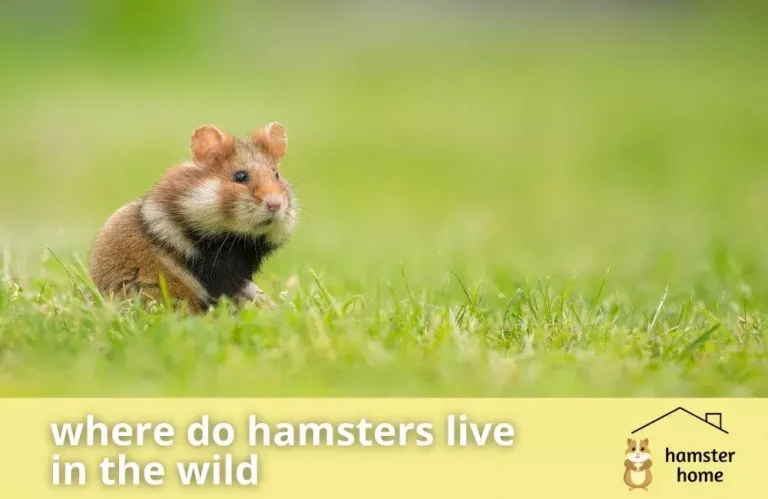Generally, hamsters live on the edges of the deserts. In fact, hamsters were discovered in Syria, a dry and warm place. However, they are also found in areas with diverse climates like Northern China, Belgium, Greece, and Romania.
Depending upon where they are found, hamsters vary in size, shape, and color. For instance, the first hamsters to be discovered, which we know as golden hamsters today, were found in Syria.
Hamsters that are found in Europe are considerably different from these golden hamsters. Wild European hamsters are big and not very docile in captivity because of their aggressive behavior.
Do you know when and who discovered the ancestors of your pet hamster? It is an exciting story that you will enjoy:
Discovery Of Hamsters
The story began in the 1930s when an Israeli Biologist named Israel Aharoni decided to find a mythical creature. In Arab culture, people called these little creatures “Mr. Saddlebags.” Yes! You guessed it right, it is because of their cheek pouches. Explorers named these Mr. Saddlebags as “Golden Hamsters.”
Although Aharoni was not very fond of traveling, he still decided to see this hyped-up creature by himself. With the help of a local hunter near the historic city of Aleppo, Aharoni succeeded in finding a female hamster with her 11 litters.
Before Aharoni’s expedition, explorers and locals misunderstood these cute little creatures as mouses. Aharoni took all 12 of these hamsters back to the University of Juraselum. It later became the foundation of the very first hamster pet industry.
At first, it wasn’t easy to contain these hamsters. The mother of the hamsters started eating her own babies. Some even escaped the captivation. Somehow the researchers managed to keep a few of those hamsters alive safely.
You might be aware that hamsters have rapid reproduction rates. Due to this reason, few hamsters turned into healthy breeding colonies in no time. This breeding colony soon turned into a proper hamster pet industry.
Later in the 1970s, people started adopting hamsters as pets because of their cuteness.
Home Of Hamsters In The Wild
You can become a better hamster owner by learning about the natural habitat of the hamsters. Ever wondered why your beloved hamster loves burrowing this much? It is because, in the wild, they burrow the soil and build tunnels underground. Hence burrowing is in their instincts.
Naturally, unlike other pets like dogs and cats, hamsters are prey animals. It means they have to be very vigilant to survive in the wilderness. To keep themselves from predators like foxes and eagles, they build nests under the ground.
They even make proper channels of tunnels to escape the predators safely. Hiding comes naturally to the hamsters. Domesticated hamsters also hide because they are hard-wired accordingly.
Bodies of the hamsters are designed perfectly for the purpose of burrowing. Their teeth always keep growing. It helps hamsters dig the soil properly without much effort. The claws of the hamsters are also shaped ideally for building tunnels beneath the ground.
Credit goes to the evolution that these harmless creatures bore the hardships of the time.
Wild hamsters are not familiar with surfaces that they can’t dig. It is why beddings like wood shavings and shredded cardboard pieces are considered the best beddings. It provides a comfortable place for the hamsters to sleep.
What Do Hamsters Eat In The Wild?
Knowledge regarding the diet of wild hamsters can help you take care of your pet hamster in a better way. Hamsters living in the wild don’t get the luxuries of surplus food around them like pet hamsters. The places where hamsters mostly live in the wild are not very forgiving.
Wild hamsters prefer eating fruits, veggies, grains, and nuts if the days are good. These are ideal food for a hamster living in the wild. Fun fact: The first Syrian hamsters were discovered in a wheat field.
When hamsters can’t find such healthy food, they even eat small animals to deal with their hunger. These creatures include small insects, lizards, frogs, and other small animals.
The digestive systems of the hamsters are not very good at getting most of their meals. It is why their feces contain a lot of undigested food. So, on worse days, when wild hamsters cannot find anything else, they even eat their own poop. It was shocking for me as well, but this is how it is.
Due to the diet, hamsters don’t live much in the wild. They catch diseases that are mainly associated with their diets at young ages. Some of the hamsters even die due to the shortage of food.
Undoubtedly, these cute little creatures face a lot in the wild.
Do All Hamsters Have The Same Ancestors?
There is a misconception that all hamsters belong to the same ancestors. This is entirely wrong. Around 26 types of hamsters occur naturally. None of these hamsters are a result of selective breeding.
All of these breeds are different in shape, size, and color from each other. Even the behavior of the hamsters depends upon their breed. Natural habitats of a few breeds are similar and close, but some of the breeds live continents away. There are no records of on-purpose breeding of hamsters to create new species either.
Hence, it is safe to say that different hamsters have different ancestors.
To understand this concept in-depth, let’s dive into the history of three popular breeds of hamsters:
Roborovski Dwarf Hamsters
It is one of the breeds of hamsters that are becoming more popular with every passing day. Roborovski hamsters got their name after their discoverer Lt. Vsevolod Roborvski. He discovered these literally tiny hamsters in 1894 somewhere in Northern China.
These furballs reached the US in 1998 and soon became popular due to their extra small size. Until the 1980s, scientists could not successfully breed these hamsters under captivation.
The behavior of these hamsters is not like any other hamsters. This breed of hamsters usually doesn’t bite, making them ideal for keeping as pets. Roborovski dwarf hamsters don’t bite. However, these hammys are pretty quick.
One moment of carelessness, and you will spend the entire day in search of these tiny creatures.
Three to four years is the average lifespan of these dwarf hamsters. Moreover, these furballs are usually sandy in color, with random white markings.
Siberian Dwarf Hamsters
Siberian Dwarf Hamsters also turned out to be excellent pets. Due to their small size and non-aggressive nature, they became ideal for families with small children.
The history of these hamsters is entirely different from the history of the Roborovski dwarf hamsters. These hamsters are also known as Djungarian Hamsters and Winter White Dwarf Hamsters. Peter Simon Pallas was the first one to identify these fantastic hamsters.
As the name suggests, these hamsters are native to Siberia, Russia. These hamsters got their nick Winter White Dwarf Hamsters because of their ability to change their coat from brown to white in the winter. Yes, that’s true. When winter arrives, Siberian hamsters shed their brown fur and grow a white one in the wild.
It provides them camouflage in all kinds of seasons. Although the origins of Roborovski and Siberian hamsters are thousands of miles away, they show similar behavior.
Both of these breeds don’t show any aggressive behavior usually. It is why they have become the favorites of many hamster owners. Moreover, they are similar in size and weight. Wild winter white hamsters can relate a little bit to the Roborovski dwarf hamsters when it comes to color.
On the other hand, domesticated Siberian Hamsters are almost entirely different because they remain white all year long.
Syrian Hamsters
The third and the most popular breed of hamsters is the “Golden Hamsters” or “Syrian Hamsters.” As mentioned above, these hamsters were identified in Syria by Israeli Biologist Israel Aharoni.
1930 was the year when Aharoni started his expedition to find this rare animal. Firstly, these golden hamsters were bred as lab animals. After some time, when researchers discovered the potential of these hamsters as pet animals, a pet industry was born. It is all due to the efforts of the Aharoni that we can keep Syrian Hamsters as pets today. It is because this breed is super rare in the wild.
You can get the idea of this breed’s rarity by the fact that the last encounter with this breed was in 1999.
Although they are thin on the ground, they have become the face of pet hamsters in the pet industry. It is because of Golden Hamster’s matchless cuteness. They have those unique cheek pouches, they are usually quite friendly, and their size is ideal. What else can one wish for in a pet?
These hamsters are generally found in three colors: Golden (the most popular one), Black, and white. In addition, the lifespan of these Mr. Saddlebags is also around 3 to 4 years.
The only purpose of discussing the history of these hamsters was to clarify the confusion for you.
From these three different breeds’ history, it’s evident that distinct breeds of hamsters have distant ancestors. The color, behavior, and size of the hamsters usually depend upon the natural habitat of their ancestors.
Do Hamsters Live Alone In The Wild?
Yes, hamsters naturally live alone in the wild. It is why they show aggressive behavior towards other hamsters and other animals. Even after the process of mating, female and male hamsters do not live together.
Female hamster raises the babies alone. Although most hamsters live alone in the wild, some domesticated breeds can live with the hamsters of the same litter. But this is quite rare and only happens if they are raised together.
Are There Any Breeds Of Hamsters Still Living In The Wild?
Out of 26 naturally occurring breeds, we keep only 5-6 breeds in our home as pets. Around 18-20 breeds of hamsters still live in the wild in different world areas.
People started keeping hamsters in 1939, which was less than a hundred years ago. It is why even the hamsters bred by the pet industry show some strange behaviors. These weird behaviors of your hamster are directly connected to its history in the wild.
Summary: All About Hamster’s History And Natural Habitat
In this article, we took a ride to the tumultuous history of the hamsters. We aimed to educate our readers so they can become better hamster owners. For this purpose, we conducted in-depth research on the history of the hamsters.
Today, the question under consideration was, “where do hamsters live in the wild?” We learned that hamsters usually prefer dry and warm climates like in Syria. Despite this fact, they are also found in diverse locations like Russia and Northern China.
Later on, in this thread, we read the exciting story of the discovery of Syrian hamsters.
After finding out about the discovery, we learned about the home of hamsters in the wild. Hamsters are prey animals, and they spend all of their lives hiding from the predators. Their survival instincts are pretty solid. On top of that, their body is explicitly evolved to help them secure themselves from predators.
There is a misconception found in most hamster owners that all hamsters have the same ancestors. In this article, we learned about the histories of three different hamster breeds, which are pretty popular.
Upon comparison, we found that the origins of all three breeds were different. It implies that all of the hamsters can’t share the same ancestors.






